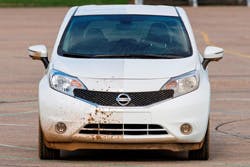In April, Nissan released a video of its all-new European market Nissan Note, coated with a special hydro- and oleophobic paint that repels water, mud, and other substances. The automaker said in a release that it planned to test the special coating for its so-called self-cleaning car in a variety of conditions.
The Ultra-Ever Dry coating, which is sold by UltraTech International, is a two-part coating developed for industrial applications that prevents water, oil, and other substances from adhering to a coated surface. According to the company, the surface chemistry creates geometric shapes in the coating with peaks that can repel water, some oils, wet concrete, and other liquids.
While the idea that your car won't ever get dirty may be attractive to some consumers, it's unlikely that the Ultra-Ever Dry coating will take off in the consumer sector any time soon. First, it has a matte finish that looks cloudy and white. Nissan opted to apply the material over the vehicle paint, but it probably wouldn't look very good over a flashy red paint job. Presently, the coating can't be tinted, although the company is actively developing a tintable version.
While Nissan is the first consumer vehicle manufacturer to test the paint, other customers have used the coating on different types of commercial and industrial vehicles. That's where the real value of the coating lies, says UltraTech engineer Paul Sander. By using it as an undercoating on construction equipment, cement trucks, snow plows, and other vehicles, operators can reduce or eliminate the build-up of mud, dirt, and other contaminants.
Think about how much moisture and salt sit on the underside of a vehicle in regions with heavy winters. Ultra-Ever Dry could potentially eliminate slush-caked wheel wells, and the rust and corrosion that come with them.
"For industrial vehicles, you can prevent mud from building up in wheel wells," Sander says. "Any areas where mud and water-based slurries get built up, undersides of vehicles or mudflaps. Those would be excellent areas for the coating to keep build-up from occurring."
The two-part coating can be applied with pneumatic HVLP sprayers. "The bottom coat is kind of like a primer, and has some adhesive in it," Sander says. "The topcoat provides the super hydro- and oleophobic properties."
"It's the same type of application process, and you can use the same HVLP equipment you'd find in a body shop," says Jarvis Phillips, warehouse manager and Ultra-Ever Dry applicator at UltraTech. "It doesn't have to be reduced. You can use the same equipment and the same types of spray patterns."
The coating was the subject of a video that went viral early in 2013, and has been viewed nearly 9 million times since.
While the coating does a good job of repelling water and other materials, Ultra-Ever Dry has a limited lifespan. "It's really application dependent," Sander says. "The thing that is really challenging for the coating is exposure to ultraviolet light over long periods of time. Based on our North American testing, it has about a one-year outdoor lifespan."
Another problem is abrasion, which can wear the coating away over time. "We're doing some testing now to see how it affects the coating, but it will depend on where the coating is applied on a vehicle," Sander says. "We expect to see the life of the coating vary widely based on exposure to UV, abrasion, and the types of weather it is exposed to on different parts of the vehicle."
One area the company definitely doesn't want you applying the coating: the windshield. "Because the coating is not clear, we don't recommend using it on windows and mirrors," Sander says.
Subscribe to ABRN and receive articles like this every month…absolutely free. Click here


